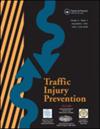开发并验证了一套轮椅在正面、侧面和后部撞击条件下的有限元模型。
IF 1.6
3区 工程技术
Q3 PUBLIC, ENVIRONMENTAL & OCCUPATIONAL HEALTH
引用次数: 0
摘要
目标:本研究的目的是开发和验证商用手动和电动轮椅的有限元(FE)模型以及相关测试夹具和绑扎硬件,为设计自动驾驶车辆和其他车辆的集成轮椅座椅站提供工具:手动轮椅模型基于 Ki Mobility Catalyst 5,电动轮椅基于配备 Synergy 座椅的 Quantum Rehab Q6 Edge 2.0。使用 3D Sense 扫描仪捕捉轮椅的几何形状。轮椅被拆卸成部件,以收集质量和其他尺寸。这些几何数据被用于构建每种产品的计算机辅助设计(CAD)模型。根据现有图纸还生成了其他夹具模型,包括代用轮椅底座 (SWCB)、代用轮椅四点绑带、传统对接硬件以及符合通用对接接口几何形状 (UDIG) 的硬件。模型在 LS-DYNA 中构建。为获得验证数据,对每辆轮椅进行了 1 到 3 次前方、横向和后方的动态雪橇测试,共进行了 13 次不同轮椅固定方法的测试。正面和后部撞击测试使用的是 Hybrid III 中型男性轮椅,而侧面撞击测试使用的是 ES-2re。正面碰撞测试的验证雪橇脉冲为 20 克-48 公里/小时,侧面碰撞测试为 10 克-22 公里/小时,后部碰撞测试为 14 克-30 公里/小时。计算了头部和胸部加速度结果的相关性和分析(CORA)得分:验证结果包括部件质量、轮椅和拟人测试装置(ATD)整体运动学、ATD头部和胸部信号的比较,以及头部和胸部加速度结果的CORA评分计算。对于两辆轮椅和深蹲通道板,模型的总质量在物理质量的 1%至 4% 之间。在 13 种测试条件中,8 种条件下的头部加速度 CORA 得分介于 0.71 到 0.92 之间,5 种条件下的头部加速度 CORA 得分介于 0.52 到 0.67 之间。胸部加速度的 CORA 分数在 8 种情况下为 0.73 至 0.96,在 5 种情况下为 0.51 至 0.67。此外,在出现残余变形的情况下,测试和模型的残余变形相似:这些公开可用的工具将使车辆安全工程师能够为坐在轮椅上的乘员设计公平的乘员保护系统。这些工具还将成为当前研究的基线,以开发适用于更多乘员尺寸的参数化轮椅模型。本文章由计算机程序翻译,如有差异,请以英文原文为准。
Development and validation of a set of wheelchair finite element models in frontal, side, and rear impact conditions
Objective
The objective of this study was to develop and validate finite element (FE) models of commercial manual and power wheelchairs, as well as related test fixtures and tiedown hardware, to provide tools for designing integrated wheelchair seating stations for automated and other vehicles.
Methods
The manual wheelchair model is based on a Ki Mobility Catalyst 5, and the power wheelchair is based on a Quantum Rehab Q6 Edge 2.0 with Synergy Seating. A 3D Sense scanner was used to capture wheelchair geometry. Wheelchairs were disassembled into components to collect masses and additional dimensions. These geometric data were used to construct computer-aided design (CAD) models of each product. Additional fixture models were generated from available drawings for the surrogate wheelchair base (SWCB), surrogate wheelchair 4-point strap tiedowns, traditional docking hardware, and hardware meeting Universal Docking Interface Geometry (UDIG). Models were constructed in LS-DYNA. For each wheelchair, between 1 and 3 dynamic sled tests in front, lateral, and rear directions were conducted for a total of 13 tests with varying wheelchair securement methods to obtain validation data. Frontal and rear impact tests used a Hybrid III midsized male, whereas the side impact tests used the ES-2re. Validation sled pulses were nominally 20 g–48 km/h for frontal tests, 10 g–22 km/h for lateral tests, and 14 g–30 km/h for rear impact tests. CORrelation and Analysis (CORA) scores were calculated for head and chest resultant accelerations.
Results
Validation results include comparison of component masses, overall wheelchair and anthropomorphic test device (ATD) kinematics, ATD head and chest signals, and calculation of CORA scores for head and chest resultant accelerations. For the 2 wheelchairs and SWCB, total model mass was within 1% to 4% of physical mass. Across the 13 test conditions, head acceleration CORA scores ranged from 0.71 to 0.92 in 8 conditions and from 0.52 to 0.67 in 5 conditions. For chest acceleration, CORA scores ranged from 0.73 to 0.96 in 8 conditions and from 0.51 to 0.67 in 5 conditions. In addition, residual deformation was similar between test and model in conditions where it occurred.
Conclusions
These publicly available tools will allow vehicle safety engineers to design equitable occupant protection systems for occupants who travel while seated in their wheelchairs. They will also be the baseline for ongoing research to develop parametric wheelchair models for additional occupant sizes.
求助全文
通过发布文献求助,成功后即可免费获取论文全文。
去求助
来源期刊

Traffic Injury Prevention
PUBLIC, ENVIRONMENTAL & OCCUPATIONAL HEALTH-
CiteScore
3.60
自引率
10.00%
发文量
137
审稿时长
3 months
期刊介绍:
The purpose of Traffic Injury Prevention is to bridge the disciplines of medicine, engineering, public health and traffic safety in order to foster the science of traffic injury prevention. The archival journal focuses on research, interventions and evaluations within the areas of traffic safety, crash causation, injury prevention and treatment.
General topics within the journal''s scope are driver behavior, road infrastructure, emerging crash avoidance technologies, crash and injury epidemiology, alcohol and drugs, impact injury biomechanics, vehicle crashworthiness, occupant restraints, pedestrian safety, evaluation of interventions, economic consequences and emergency and clinical care with specific application to traffic injury prevention. The journal includes full length papers, review articles, case studies, brief technical notes and commentaries.
 求助内容:
求助内容: 应助结果提醒方式:
应助结果提醒方式:


